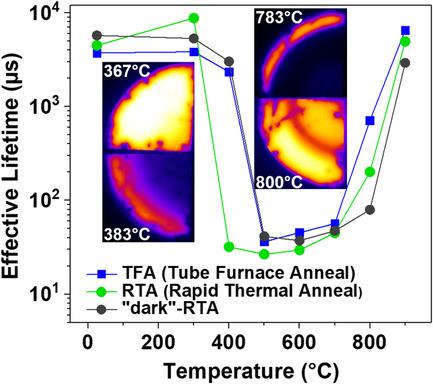当前位置:
X-MOL 学术
›
Phys. Status Solidi A
›
论文详情
Our official English website, www.x-mol.net, welcomes your
feedback! (Note: you will need to create a separate account there.)
Kinetics of Bulk Lifetime Degradation in Float‐Zone Silicon: Fast Activation and Annihilation of Grown‐In Defects and the Role of Hydrogen versus Light
Physica Status Solidi (A) - Applications and Materials Science Pub Date : 2020-07-28 , DOI: 10.1002/pssa.202000436 Daniel Hiller 1 , Vladimir P. Markevich 2 , Joyce Ann T. de Guzman 2 , Dirk König 3, 4 , Slawomir Prucnal 5 , Wolfgang Bock 6 , Jaakko Julin 5, 7 , Anthony R. Peaker 2 , Daniel Macdonald 1 , Nicholas E. Grant 8 , John D. Murphy 8
Physica Status Solidi (A) - Applications and Materials Science Pub Date : 2020-07-28 , DOI: 10.1002/pssa.202000436 Daniel Hiller 1 , Vladimir P. Markevich 2 , Joyce Ann T. de Guzman 2 , Dirk König 3, 4 , Slawomir Prucnal 5 , Wolfgang Bock 6 , Jaakko Julin 5, 7 , Anthony R. Peaker 2 , Daniel Macdonald 1 , Nicholas E. Grant 8 , John D. Murphy 8
Affiliation

|
Float‐zone (FZ) silicon often has grown‐in defects that are thermally activated in a broad temperature window (≈300–800 °C). These defects cause efficient electron‐hole pair recombination, which deteriorates the bulk minority carrier lifetime and thereby possible photovoltaic conversion efficiencies. Little is known so far about these defects which are possibly Si‐vacancy/nitrogen‐related (VxNy). Herein, it is shown that the defect activation takes place on sub‐second timescales, as does the destruction of the defects at higher temperatures. Complete defect annihilation, however, is not achieved until nitrogen impurities are effused from the wafer, as confirmed by secondary ion mass spectrometry. Hydrogenation experiments reveal the temporary and only partial passivation of recombination centers. In combination with deep‐level transient spectroscopy, at least two possible defect states are revealed, only one of which interacts with H. With the help of density functional theory V1N1‐centers, which induce Si dangling bonds (DBs), are proposed as one possible defect candidate. Such DBs can be passivated by H. The associated formation energy, as well as their sensitivity to light‐induced free carriers, is consistent with the experimental results. These results are anticipated to contribute to a deeper understanding of bulk‐Si defects, which are pivotal for the mitigation of solar cell degradation processes.
中文翻译:

浮区硅中的大块寿命降解动力学:生长缺陷的快速活化和An灭以及氢与光的作用
浮区(FZ)硅通常会产生缺陷,这些缺陷会在较宽的温度窗口(约300–800°C)中被热激活。这些缺陷导致有效的电子-空穴对重组,从而降低了少数载流子的寿命,从而可能提高了光电转换效率。到目前为止,对于这些可能与硅空位/氮相关的缺陷(V x N y)知之甚少。)。此处表明,缺陷激活在亚秒级的时间范围内发生,在较高温度下破坏缺陷也是如此。然而,直到从晶片上喷出氮杂质为止,才能完全消除缺陷,这是通过二次离子质谱法证实的。氢化实验揭示了重组中心的暂时和仅部分钝化。结合深层瞬态光谱,至少可以发现两种可能的缺陷状态,其中只有一种与H相互作用。借助密度泛函理论V 1 N 1提出了引发Si悬挂键(DB)的中心作为一种可能的缺陷候选物。此类DB可以被H钝化。相关的形成能及其对光诱导自由载流子的敏感性与实验结果一致。预期这些结果将有助于更深入地了解体硅缺陷,这对于减轻太阳能电池的降解过程至关重要。
更新日期:2020-09-08
中文翻译:

浮区硅中的大块寿命降解动力学:生长缺陷的快速活化和An灭以及氢与光的作用
浮区(FZ)硅通常会产生缺陷,这些缺陷会在较宽的温度窗口(约300–800°C)中被热激活。这些缺陷导致有效的电子-空穴对重组,从而降低了少数载流子的寿命,从而可能提高了光电转换效率。到目前为止,对于这些可能与硅空位/氮相关的缺陷(V x N y)知之甚少。)。此处表明,缺陷激活在亚秒级的时间范围内发生,在较高温度下破坏缺陷也是如此。然而,直到从晶片上喷出氮杂质为止,才能完全消除缺陷,这是通过二次离子质谱法证实的。氢化实验揭示了重组中心的暂时和仅部分钝化。结合深层瞬态光谱,至少可以发现两种可能的缺陷状态,其中只有一种与H相互作用。借助密度泛函理论V 1 N 1提出了引发Si悬挂键(DB)的中心作为一种可能的缺陷候选物。此类DB可以被H钝化。相关的形成能及其对光诱导自由载流子的敏感性与实验结果一致。预期这些结果将有助于更深入地了解体硅缺陷,这对于减轻太阳能电池的降解过程至关重要。











































 京公网安备 11010802027423号
京公网安备 11010802027423号